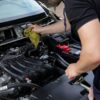How to Choose the Right OEM Volkswagen, Audi, Mercedes-Benz, BMW, Volvo Parts for Your Car: A Comprehensive Car Parts Compatibility Guide.
The use of Original Equipment Manufacturer (OEM) parts is critical for maintaining the performance, safety, and longevity of luxury vehicles such as Volkswagen, Audi, Mercedes-Benz, BMW, and Volvo. This paper provides a detailed guide on how to select the correct OEM parts for these vehicles, highlighting common mistakes and offering tips to ensure compatibility. Following this car parts compatibility guide ensures you select OEM components that maintain your vehicle’s integrity.
Introduction
This comprehensive car parts compatibility guide will help you navigate the complexities of selecting the right OEM parts for luxury vehicles such as Volkswagen, Audi, Mercedes-Benz, BMW, and Volvo. Luxury vehicles from brands like Volkswagen, Audi, Mercedes-Benz, BMW, and Volvo are engineered with precision and built to exacting standards. When it comes to maintenance and repair, using OEM parts ensures that the vehicle retains its original performance and safety specifications. OEM parts are designed by the manufacturer specifically for a particular make and model, offering a perfect fit and optimal functionality. This paper will discuss the importance of choosing OEM parts, provide a step-by-step guide on the selection process, and address common pitfalls and tips for ensuring compatibility.
Importance of Choosing OEM Parts
Quality Assurance
OEM parts are manufactured to the same specifications and standards as the original components. This ensures that they fit perfectly and function as intended, maintaining the vehicle’s performance and safety.
Warranty and Reliability
Using OEM parts can preserve the vehicle’s warranty, as many manufacturers specify the use of such parts to keep the warranty valid. Furthermore, OEM parts tend to be more reliable and durable compared to aftermarket alternatives.
Resale Value
Vehicles maintained with OEM parts often have higher resale values. Prospective buyers are more confident in the condition and maintenance history of a vehicle that has been serviced with OEM components.
Step-by-step Car Parts Compatibility Guide to Selecting the Correct OEM Parts
Step 1: Identify the Exact Part Needed
Consult the Owner’s Manual
The owner’s manual is the primary source of information for understanding the specific parts required for your vehicle. It contains part numbers, specifications, and detailed diagrams.
Use Online Parts Catalogs
Manufacturers often provide online parts catalogs that can be accessed using the vehicle’s VIN (Vehicle Identification Number). These catalogs provide detailed part numbers and descriptions, making it easier to identify the exact part needed.
Step 2: Verify the Part Number
Cross-Reference with Manufacturer Databases
Once you have identified the part number from the owner’s manual or online catalog, cross-reference it with manufacturer databases. This step ensures that the part number is current and has not been superseded by a newer version.
Step 3: Source the Part from Authorized Dealers or Reputable Online Stores
Purchase from Authorized Dealerships and Reputable Online Stores
To guarantee the authenticity of the OEM part, purchase from authorized dealerships or reputable online stores that specialize in OEM parts, such as Carpartas.com. Carpartas.com have direct access to the manufacturer’s parts inventory and can order specific components if they are not in stock.
Verify Dealer Reputation
Before making a purchase, verify the reputation of the dealership. Look for customer reviews and ratings to ensure that they provide genuine parts and good customer service.
Step 4: Check for Part Authenticity
Inspect Packaging and Labels
OEM parts typically come in branded packaging with part numbers and labels. Inspect these carefully to ensure they match the details provided by the manufacturer.
Use Manufacturer Verification Tools
Some manufacturers provide verification tools, such as QR codes or online portals, to check the authenticity of parts. Utilize these tools to confirm that the part is genuine.
Step 5 of Car Parts Compatibility Guide: Confirm Compatibility
Match Part Numbers
Ensure that the part number matches exactly with the one specified for your vehicle. Small discrepancies in part numbers can indicate differences in specifications or fit.
Consult with a Mechanic
If in doubt, consult with a certified mechanic who specializes in your vehicle’s brand. They can provide professional advice on compatibility and installation.
Car Parts Compatibility Guide: Common Mistakes and Tips
Mistake 1: Assuming All Parts Are Interchangeable
Different models and years can have slight variations in parts. Always verify that the part is specified for your exact make, model, and year.
Tip 1: Use VIN for Accuracy
The VIN is unique to your vehicle and can be used to ensure that you are getting the correct part. Provide the VIN when ordering parts to avoid mistakes.
Mistake 2: Buying from Unverified Sources
Purchasing parts from unverified sources can result in counterfeit or substandard components.
Tip 2: Stick to Authorized Dealers and Reputable Online Stores
Always buy from authorized dealers or reputable online stores that specialize in OEM parts, such as Carpartas.com. Such stores have long-term wholesale agreements with factories, ensuring they provide authentic parts. Carpartas.com also assists in finding the appropriate original part using factory catalogs and often offers these parts at a lower price than local dealers.
Mistake 3 of Car Parts Compatibility Guide: Ignoring Part Updates or Revisions
Manufacturers sometimes update parts to improve performance or address issues. Ignoring these updates can lead to compatibility problems.
Tip 3: Stay Updated on Manufacturer Bulletins
Subscribe to Carpartas.com newsletters to stay informed about part updates and revisions.
Car Parts Compatibility Guide: Conclusion
Choosing the right OEM parts for Volkswagen, Audi, Mercedes-Benz, BMW, and Volvo vehicles requires careful attention to detail and a systematic approach. By following the steps outlined in this guide, car owners and technicians can ensure that they select the correct parts, maintain vehicle performance, and avoid common pitfalls. Using genuine OEM parts not only preserves the integrity of the vehicle but also provides peace of mind regarding safety and reliability.










